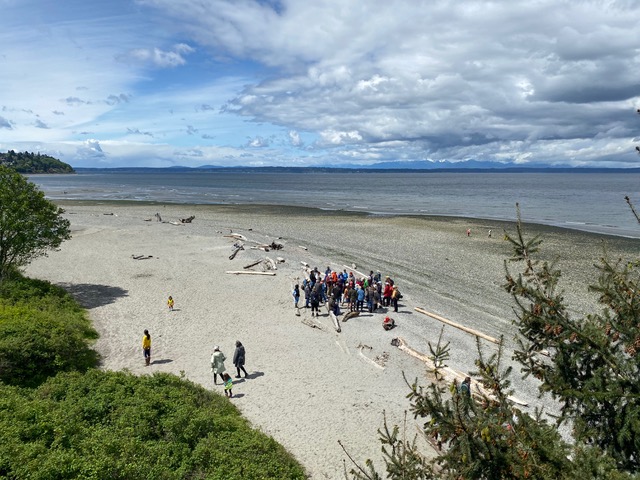By Sally Yakasaki
Have you taken a walk on a beach and pondered the history that lay at your feet?
Local History Field Trip #2 qWátəb : Duwamish Clam Garden, taught me to do just that.
On a beautiful low tide day over 40 people gathered at Carkeek Park to listen and learn from local historian and author David Buerge as he told us about qWátəb: Lushootseed for clam garden.
On a beautiful low tide day over 40 people gathered at Carkeek Park to listen and learn from local historian and author David Buerge as he told us about qWátəb: Lushootseed for clam garden.
On the field trip he also shared other historic information.
 |
| David is author of Chief Seattle book |
According to Buerge, clam gardens at Carkeek Park were tended by the Sheel shol AHBSH (šilšola’bš) the people of Salmon Bay in Ballard.
The gardens were sections of beach where the people removed large and small boulders to provide more space for clams to live, feed and propagate.
The gardens were developed at the mouths of streams that brought nutrients down to the beach, enriching the clam diet, explained Buerge.
With some clam gardens, in order to provide food and more nutrients, the people would make a line of smaller rocks placed on the seaward side to break up wave action and keep the nutrients in place.
With some clam gardens, in order to provide food and more nutrients, the people would make a line of smaller rocks placed on the seaward side to break up wave action and keep the nutrients in place.
 |
| Buerge and group at Carkeek Park |
These clam gardens enabled people to domesticate mollusks.
In addition to domesticating mollusks, Buerge discussed the domestication of plants.
Stinging nettles were one example of a plant that was raised.
Buerge described the duck catching nets that were made and how they were used.
More field Trips are being planned. If you would like to be notified of the next upcoming fields trips, you can reference the Shoreline Historical Museum at:
“They had fields and fields of stinging nettles; a thousand acres of them up on Whidbey Island,” said Buerge.
“They would raise them because the outer skin of the stems of stinging nettles were very fibrous and strong.”
The stems of the stinging nettles would then be made into nets.
 |
| David Buerge, K Kelly from Knowing Place, and Kenneth Doutt, Director at the Shoreline Historical Museum |
Buerge described the duck catching nets that were made and how they were used.
“They had these big-long nets. There was one at Agate Pass that was 700 feet long. It probably wasn’t the length of the net, but the lines that elevated the net across Agate Pass.”
“They would raise these nets up at nighttime or on foggy days and then scare the birds so that birds would take flight and get caught in the nets and then drop down and the people would pick them up -- thousands of birds around 15 pounds each.” explained Buerge.
“Back then, there were as many birds in this area as there were salmon migrating up in the streams. And this was a source of protein equal to that in fish. Domesticating mollusks and plants back then was a really remarkable engagement with the environment,” Buerge said.
 |
| Field trip #2 at Carkeek Park |
More field Trips are being planned. If you would like to be notified of the next upcoming fields trips, you can reference the Shoreline Historical Museum at:
- Facebook (https://www.facebook.com/shorelinehistoricalmuseum),
- The website event page (https://shorelinehistoricalmuseum.org/programs-and-fun-stuff/) or
- reach out to the museum via email (shm@shorelinehistoricalmuseum.org).Or
- Knowing Place on Facebook.


No comments:
Post a Comment
We encourage the thoughtful sharing of information and ideas. We expect comments to be civil and respectful, with no personal attacks or offensive language. We reserve the right to delete any comment.